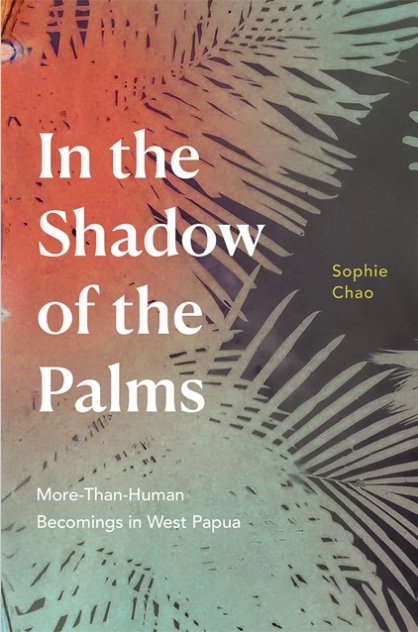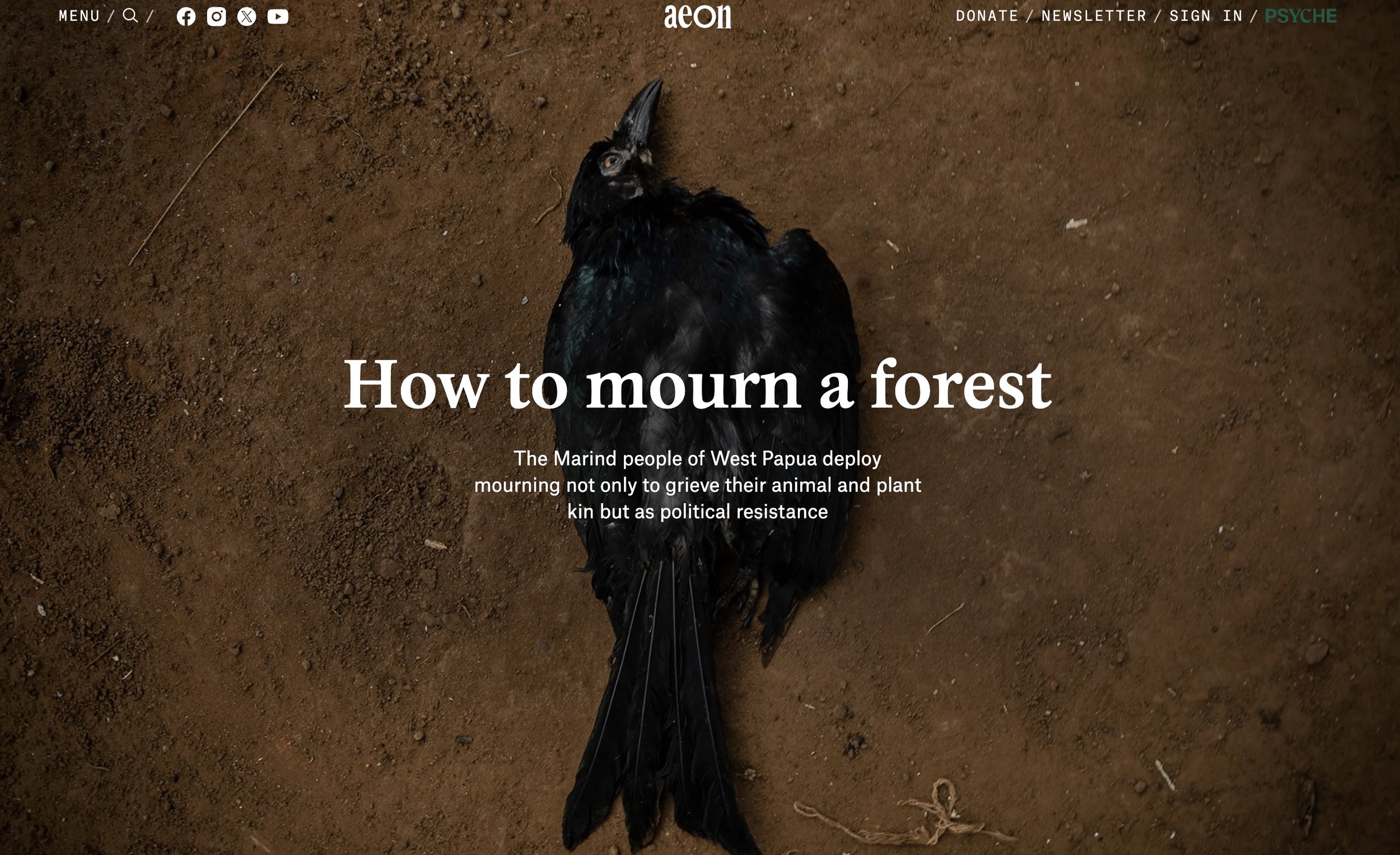On 14th May I attended a postgraduate masterclass and lecture arranged by Michele Bastian for the Environmental Humanities Research Network at Edinburgh University. The masterclass was with Dr Sophie Chao, a Sidney based human rights advocacy scholar turned anthropologist who has conducted extended field research with the Marind people of West Papua. The Marind are experiencing a catastrophic disposession and loss of ecosystem due to the industrial introduction of oil palm plantations.
I was deeply moved by Dr Chao’s devastating performance of her Marind friend’s Andreas’ poetry, which she included as part of her lecture following the masterclass. This poem is a song composed to mourn a snake she and Andreas found abandoned on a road. It had been run over by an agricultural vehicle associated with the palm plantation, and was dying an ‘undignified’ death, alone and unacknowledged. The Marind cannot just continue and pass by as we in the UK might do with ‘roadkill’ (however momentarily sad the sight might be). Honouring Marind values means being compelled to stop and witness this forest creature’s suffering as one of their friends. The unnecessary death of the forest dweller ‘must be mourned’ with tears and song.
Her book In The Shadow of the Palms (2022, Duke University Press) and a further monograph (forthcoming) are some of the academic outcomes of her experiences, but she also publishes widely in non-academic forms such as the blogpost at Aeon which describes Marind processes of making and mourning and how these function as acts of healing and resistance.
I was moved to write to Dr Chao to thank her for speaking to our PhD group, and I’ve reproduced the email below, because it’s important for me to remember how I felt at the time as I continue to develop my current work.
Dear Dr Chao
If you have flown back to Australia by the time you read this I hope the travelling was smooth, that the book is doing well, and that the jet lag is not too debilitating.
I was one of the PhD students from Edinburgh College of Art who attended your masterclass and lecture on Tuesday 14th May. I just wanted to write and let you know how inspired I was by your words and presence. Your responses to our questions in the masterclass were so thoughtful and insightful, and your lecture was truly devastating in all the best ways. I hope nobody saw (one is not supposed to cry in an academic setting, right?) but I was moved to full-on tears by your reading of the song that your Marind friend composed to the dying snake.
I asked you about joy and hope and self-care. You cautioned upon thinking in terms of hope when it comes to the Marind, but you mentioned some of the practices of "making and mourning" such as weaving and singing as acts of healing. I’ve now found your Aeon blogpost, and your article on Multispecies Mourning, which beautifully describe the collective acts of weaving, mourning, storying and weeping in more detail, thank you! I offered you the phrase ‘joy in mourning’, which is perhaps not quite the right way to put it. But for me there can be a fierce joy in mourning very deeply since, as you explain in your articles, the way that we mourn, and what we mourn is a powerful expression of what we hold dear, of who we are, and of the fact that we are still alive.
Thanks to your generous pedagogy I have now got the breakthrough I was looking for in approaching my next film project. I realised finally that the discomfort I spoke of in your masterclass (at the tension between the desire to know and ‘illuminate’ in both science and art, and the contradictory but related desire to protect and respect) is in fact the subject of the artwork I want to make, rather than something to be gotten over or moved on from. Your comment about the conflicting temporalities that are present in that tension was also very thought provoking. I am still sitting with what else this insight might facilitate in my thinking - thank you.
I often work with words or phrases as verbal touchstones when developing artworks, and Your phrase ‘making and mourning’ resonates with me very powerfully as an artist/maker. This phrase will be how I keep the emotional core of the subject present as I weave together the multiple threads of my research.
What can I say? I do hope you can forgive me the indulgence of this email. It is my way to offer heartfelt thanks for what was so much more that the standard academic lecture.
It was very special.
With warmest wishes
Victoria Evans
“Sami, Sami, you slip, you slide
Sister of the forest, sister of the grove
Sami, Sami, you weave, you glide
Sister of the river, sister of the swamp
Your skin is sleek and shiny, patterned by the land
Silent and shy, you slither across the land
Moving soil and leaf, patterning the land.
Here you lie, Sami, snake sister
Your body crushed, your wetness gone
I cannot bear to look at you, I cannot bear to leave
The trucks and cars, they took away your life
Robbed you of your wetness, robbed you of your pride.
Here you lie, Sami, snake sister
Your body crushed, your wetness gone
I cannot bear to look at you, I cannot bear to leave
The trucks and cars, they took away your life
Robbed you of your wetness, robbed you of your pride.
Here you lie, Sami, sister snake
I was not here to save you, I could not spare you death
Sami, Sami, in leaves and fronds, I’ll wrap you
With my arms and my legs, I’ll take you
To a quiet, green place, I’ll carry you
To that place where your fathers and forefathers were born.
And there, you will find rest
In the cool shade of the forest, you can sleep
There, no pain or dust will haunt you
The rain and soil will hold you
This nightmare will release you
I beseech you, accept from me this song
Through it you will live on.”
Chao, S. (2023). "Multispecies Mourning: grieving as resistance on the West Papuan plantation frontier." Cultural Studies 37(4): 553-579.
Abstract
This article explores the cultural, political, and affective significance of mourning among the Indigenous Marind communities of rural Merauke West Papua, whose intimate and ancestral relations to native plants, animals, and ecosystems are increasingly threatened by mass deforestation and monocrop oil palm expansion. Cross-pollinating Indigenous more-than-human philosophies with environmental humanities scholarship, I examine three emergent practices of ?multispecies mourning? on the Papuan oil palm frontier ? the weaving of sago bags as a form of collective healing, the creation of songs prompted by encounters with roadkill, and the transplanting of bamboo shoots as part of customary land reclaiming activities. Multispecies mourning offers potent avenues for Marind to memorialize the radical loss of lives and relations prompted by capitalist landscape transformations. At the same time, multispecies mournings constitute forms of active resistance and creative refusal in the face of extractive capitalism?s ecocidal logic. Bringing together plants, people, and places, their dispersed sentience and materiality offer hopeful pathways for multispecies solidarities, in and against the rubble of agro-industrialism and its necropolitical undergirdings.
Dr Chao has kindly invited me to keep in touch and to send me her latest article when it is ready. The article will include more detail on a topic Dr Chao mentioned in the masterclass which intrigued me greatly. She described how the Marind preferred their own video perspective on the forest - hours and hours of unedited footage from the back of a motorbike driving through tracks in the forest/now plantation. shot from the phone camera close, blurred, partial, lacking in obvious structure, as opposed to the top down drone footage employed by outsiders. The Marind acknowledge that this top down perspective is useful, in that it effectively shows the scale and extent of the devastation in communication with other non-Marind stakeholders or adversaries, but according to Dr Chao they do not like it, instead preferring to watch their own self shot footage, however monotonous or unintelligible that might perhaps appear to a non-Marind viewer. This footage relates to their own lived experience of habitat destruction in the way that the drone footage does not.
This preference for the intimate, partial, and sensorially immersive grass roots perspective, reminds me of some feminist, queer and diasporic film-making strategies that prioritise haptic, relational and affective aesthetics over established, rationalist versions of (visual) cinematic intelligibility (Fisher, 1997; Marks, 2000; Quinlivan, 2015,;Sobchack, 2004) as a radical alternative to the objectifying and pseudo-omniscient, totalising gaze (really just another unacknowledged partial perspective) of commercial cinema. This is achieved partly through refusing to distance and separate the camera from it’s subject. Instead, techniques of close framing, blurring, and a deliberate indistinctness between bodies and ground, emphasises the immediacy of tactile and affective experience over a rationalist conception of bodies as ordered, distinct, separate from their surroundings or rendered as a/o-bject(s) (and therefore exploitable).
Fisher, J. (1997). Relational Sense: Towards a Haptic Aesthetics. Parachute: Contemporary Art Magazine: 4-11.
Marks, L. U. (2002). Touch : sensuous theory and multisensory media. Minneapolis, Minneapolis : University of Minnesota Press.
Marks, L. U. (2004). "Haptic visuality: Touching with the eyes." Framework: The Finnish Art Review 2(November).
Quinlivan, D. (2015). "On How Queer Cinema Might Feel." Music, Sound and the Moving Image 9(1): 63-77,98.
Sobchack, V. C. (2004). Carnal Thoughts Embodiment and Moving Image Culture. Berkeley, Berkeley : University of California Press.


